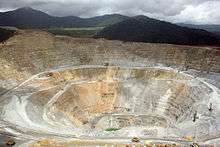Batu Hijau mine
The Batu Hijau mine is an open pit copper-gold mine operated by PT. Amman Mineral Nusa Tenggara. The mine is located 1,530 kilometres (950 mi) east of the Indonesian capital Jakarta on Sumbawa, in southern Taliwang Regency, an island in West Nusa Tenggara. The mine is the result of a ten-year exploration and construction program based on a 1999 discovery of the porphyry copper deposit. Production began in 2000.
| Location | |
|---|---|
 Batu Hijau Mine Location in Indonesia | |
| Location | Sumbawa |
| Province | West Nusa Tenggara |
| Country | Indonesia |
| Coordinates | 08°58′S 116°52′E |
| Production | |
| Products | Copper gold |
| Production | 141.9 Million Pounds Copper 70.9 Thousand Ounces Gold |
| Financial year | 2018 |
| History | |
| Opened | 2000 |
| Closed | 2025 |
| Owner | |
| Company | PT. Amman Mineral Nusa Tenggara |
| Website | PT. Amman Mineral Nusa Tenggara |

The mine utilizes a "truck and shovel" open-pit mining method, with ore reporting to semi-Autogenous Grinding and ball mills, followed by a flotation circuit. The finished product is a thickened copper-gold concentrate, which is shipped via pipe to a storage facility on the Indonesian coast.
History
In 1990 mineral exploration on the island of Sumbawa resulted in the discovery of copper mineralization that would be developed into the Batu Hijau mine.[1] The deposit was named for the discovery outcrop, a bright-green oxide-copper occurrence; in Indonesian, "Batu Hijau" means "green rock." [2] Over the next ten years PT Newmont Nusa Tenggara delineate the resource and began developing the mine and building the required infrastructure. In 1999 construction was complete and by the next year Batu Hijau was producing ore.[3]
In 2016, Newmont Mining Corporation successfully completed the sale of its ownership stake in PT Newmont Nusa Tenggara, which operates the Batu Hijau copper and gold mine in Indonesia, to PT Amman Mineral Nusa Tenggara.
Geology and ore reserves
The orebody at Batu Hijau is a porphyry copper type and includes a high gold component, which is common for such copper deposits in southeast Asia. The host rock for porphyry copper deposits in southeast Asia is typically diorite and quartz diorite. Copper sulphides such as chalcopyrite and bornite are frequently associated with the gold component of these deposits.
As of the end of 2008, Batu Hijau had an ore reserve of 968mt of ore at 0.41% Cu and 0.29g/t Au. [3]
Mining & milling

Batu Hijau is an open-pit mine. Ore is removed from the mining face using P&H 4100 electric shovels (pictured) and loaded into Caterpillar 793C haul trucks. Each haul truck can move a payload 220 t (240 short tons) of ore. The trucks haul ore from the shovel to primary crushers. Crushed ore is sent by a conveyor 1.8 m (6 ft) wide and 6.8 km (4.2 mi) long to the mill. Daily production from the mine is an average of 600,000 t (660,000 short tons) ore and waste combined. Ore from the mine has an average copper grade of 0.49% and an average gold grade of 0.39g/t.[3]
Crushed ore is further reduced in size by Semi-Autogenous Grinding and ball mills. Once milled it is sent through a flotation circuit which produces a concentrate with a grade of 32% copper and 19.9g/t gold.[3] The mill realizes a copper recovery of 89%.[4] The concentrate is thickened into slurry and piped 17.6 km (10.9 mi) to the port at Benete where water is removed from the slurry. The concentrate storage at the port can hold 80,000 t (88,000 short tons) of copper-gold concentrate.[3]
Environmental issues
Disposal of tailings from the processing operation of the Batu Hijau mine takes place in the ocean, using a process called Submarine Tailings Disposal (STD). Indonesia is currently the only location that PT. Amman Mineral Nusa Tenggara uses this process, claiming that it is more an environmentally sound practice despite being more costly to the company. The process involves piping the tailings 2.1 miles (3.4 km) off the coast to a drop-off of 400 feet (120 m), which carries the waste down another 10,000 feet (3,000 m). Waste rock from the Batu Hijau mine is disposed of in the rainforest, with space for newly produced waste rock running out. Environmentalists are raising concern with the declining population of the yellow-crested cockatoo.
References
- "Batu Hijau mine site - Infomine". InfoMine. Retrieved 2009-04-03.
- Jack H. Morris, Going for Gold: the history of Newmont Mining. 2010, University of Alabama Press, ISBN 0817316779
- "Batu Hijau Copper-Gold Mine, Indonesia". Mining Technology. Archived from the original on 16 April 2009. Retrieved 2009-04-02.
- Tse, Pui-Kwan (2002). "The Mineral Industries of Indonesia and East Timor (Timor Leste)" (PDF). United States Geological Survey. Cite journal requires
|journal=(help)
External links
- PT. Amman Mineral Nusa Tenggara, official website